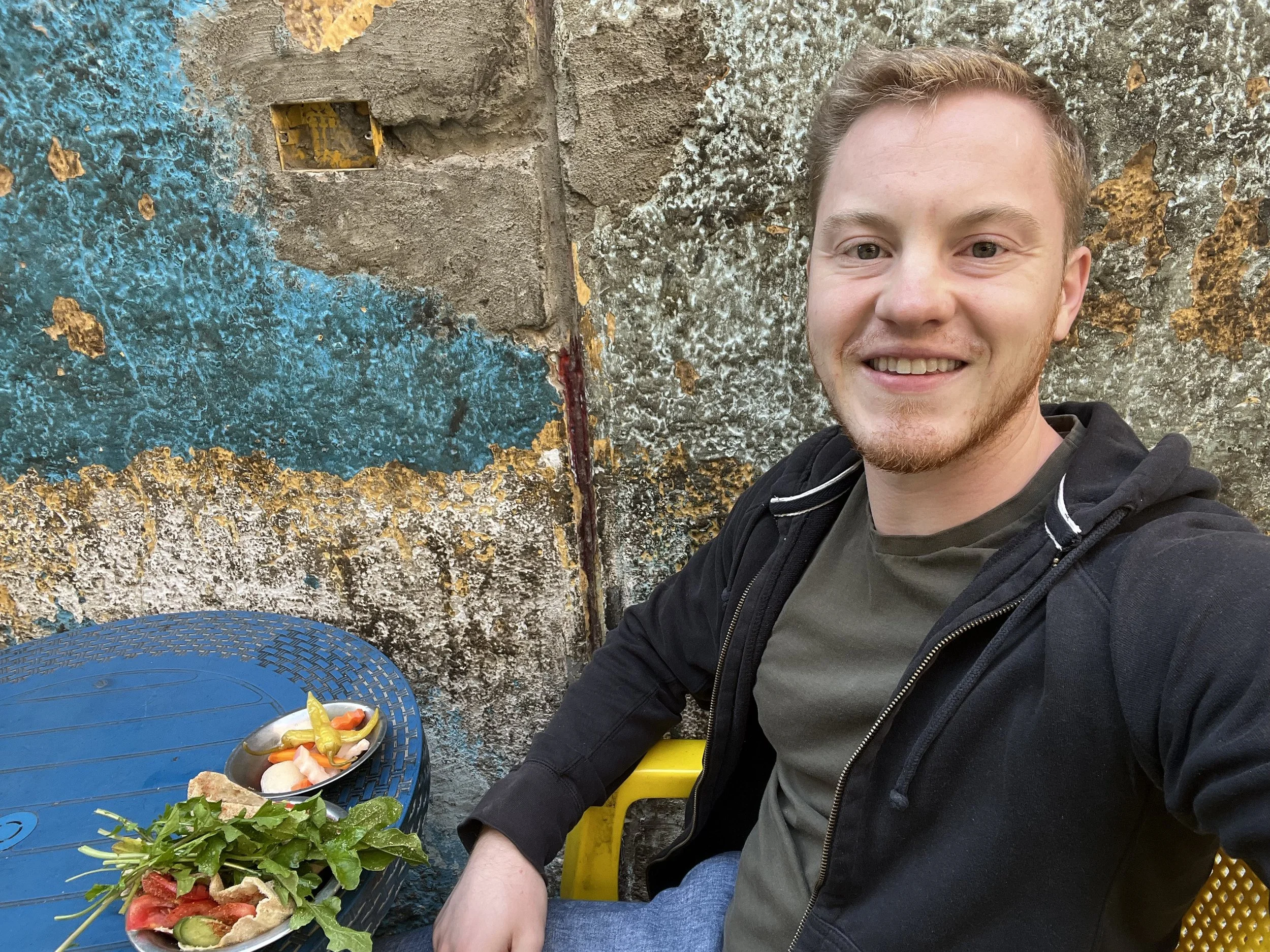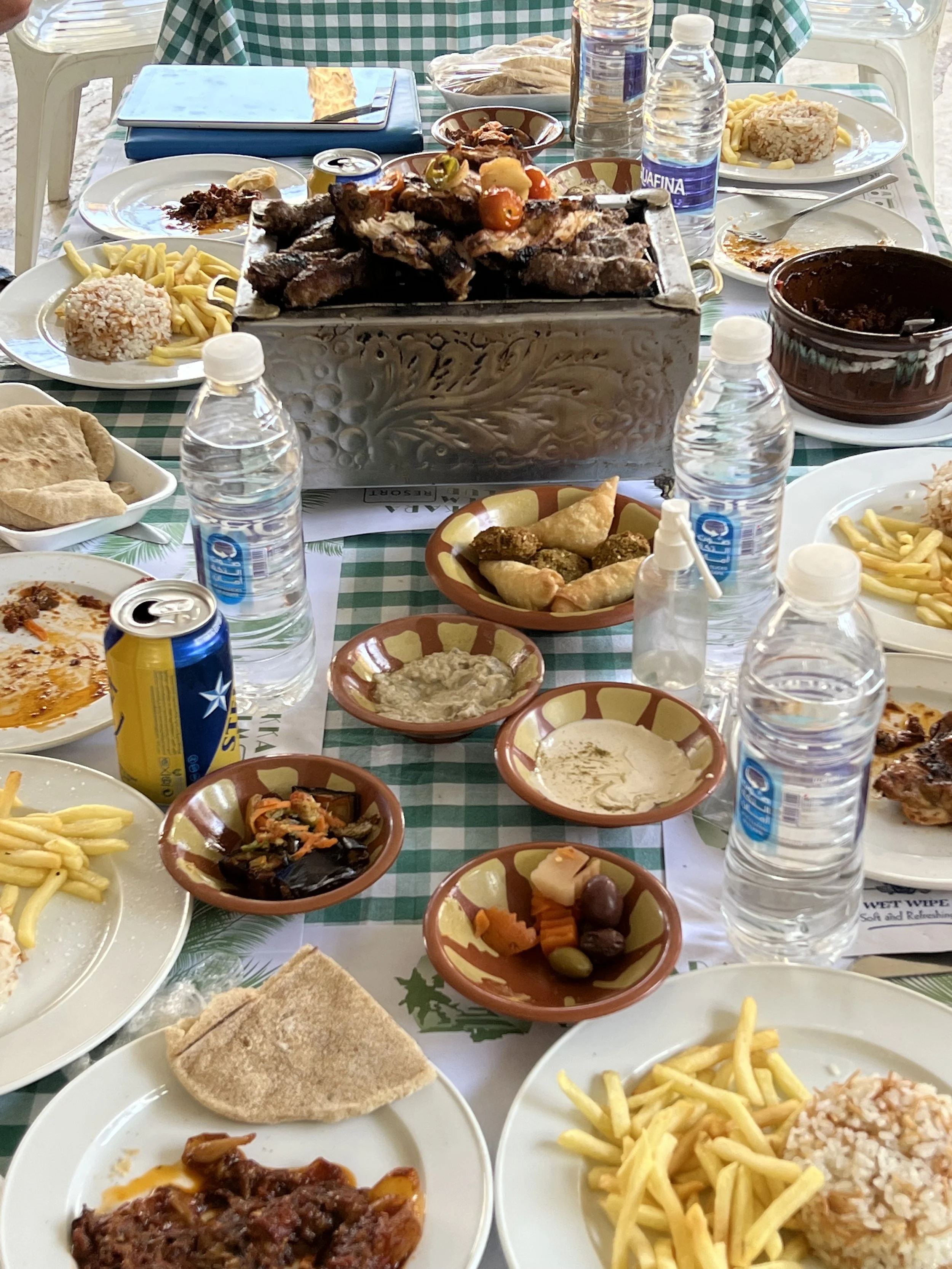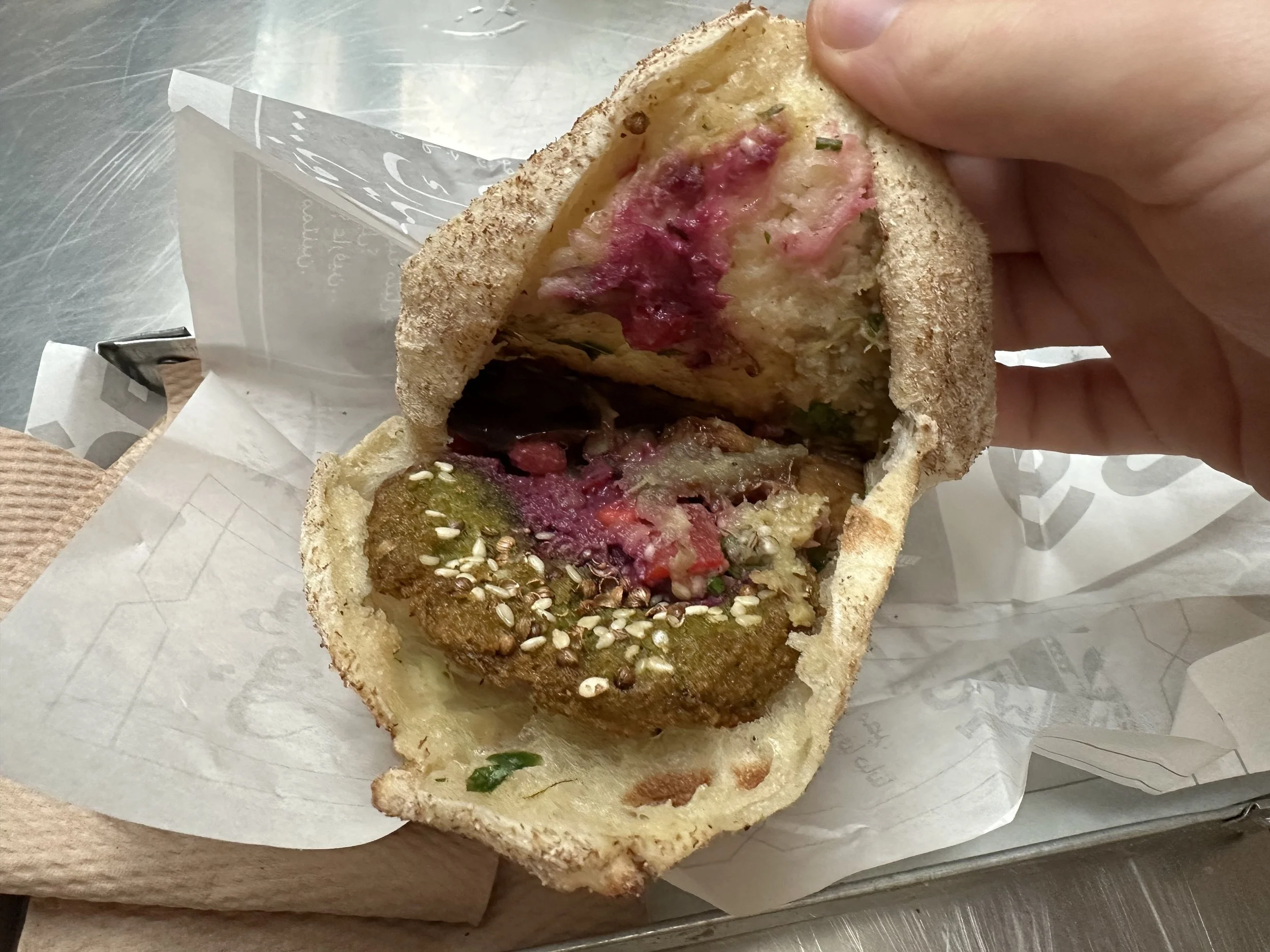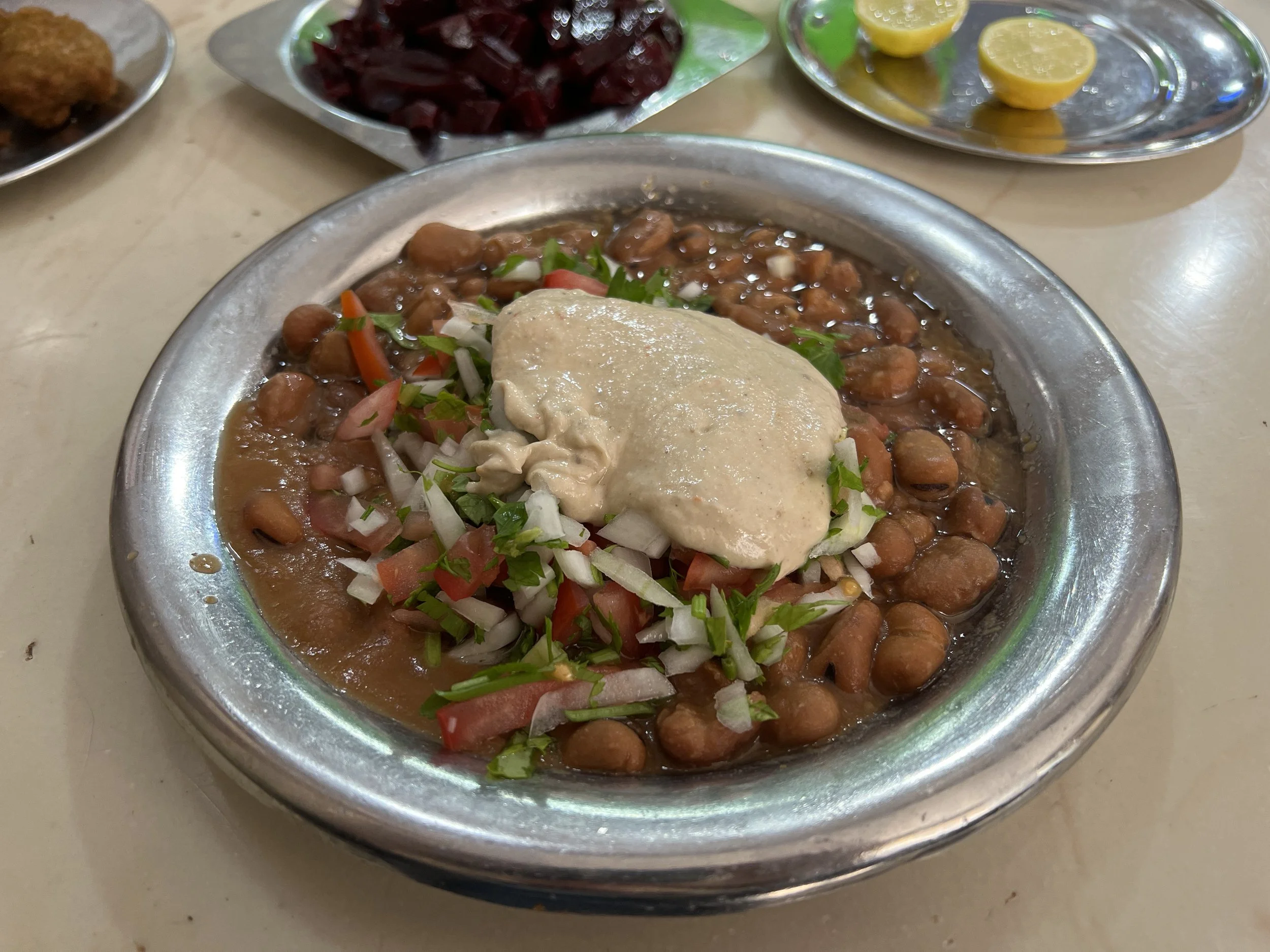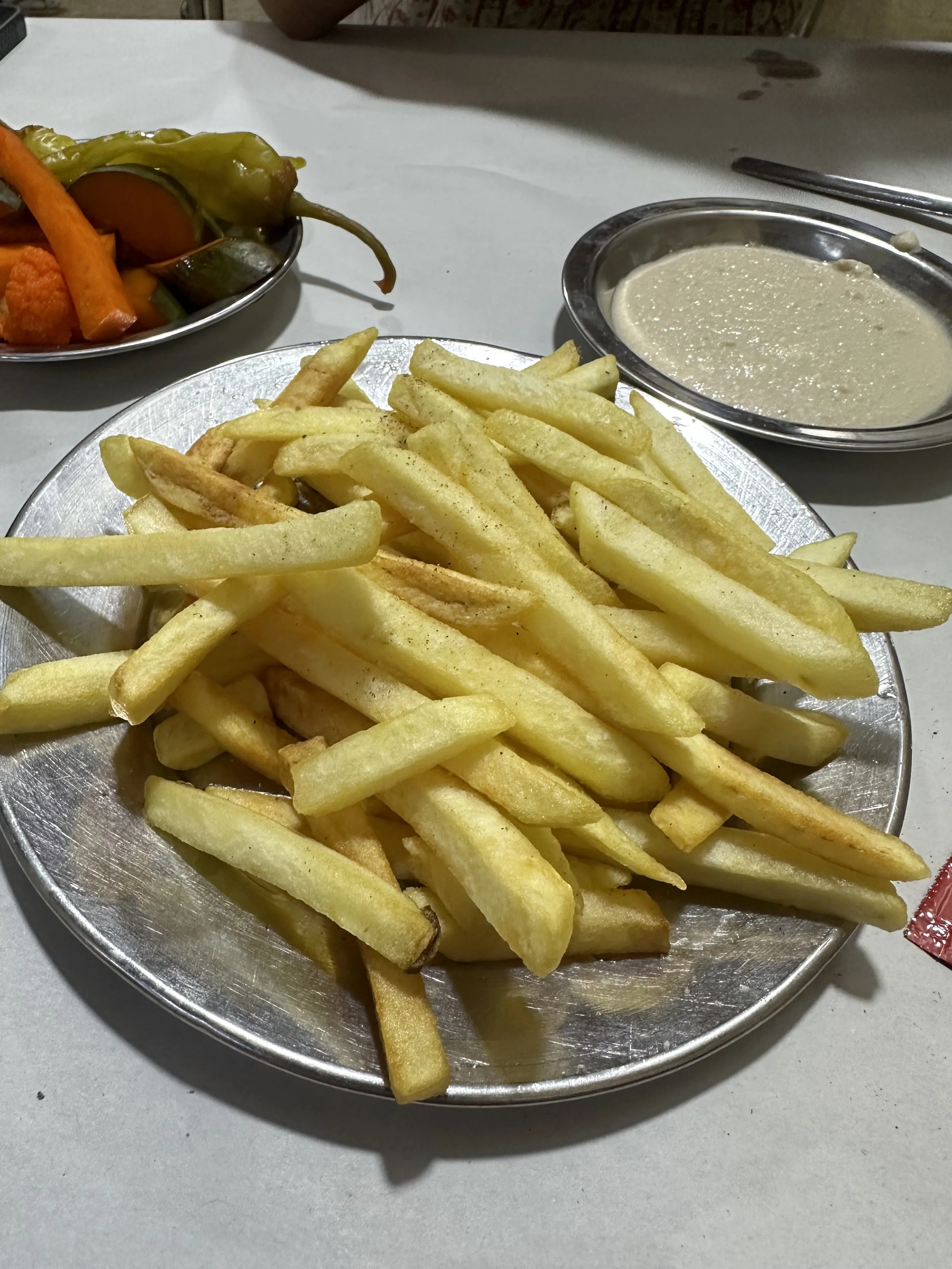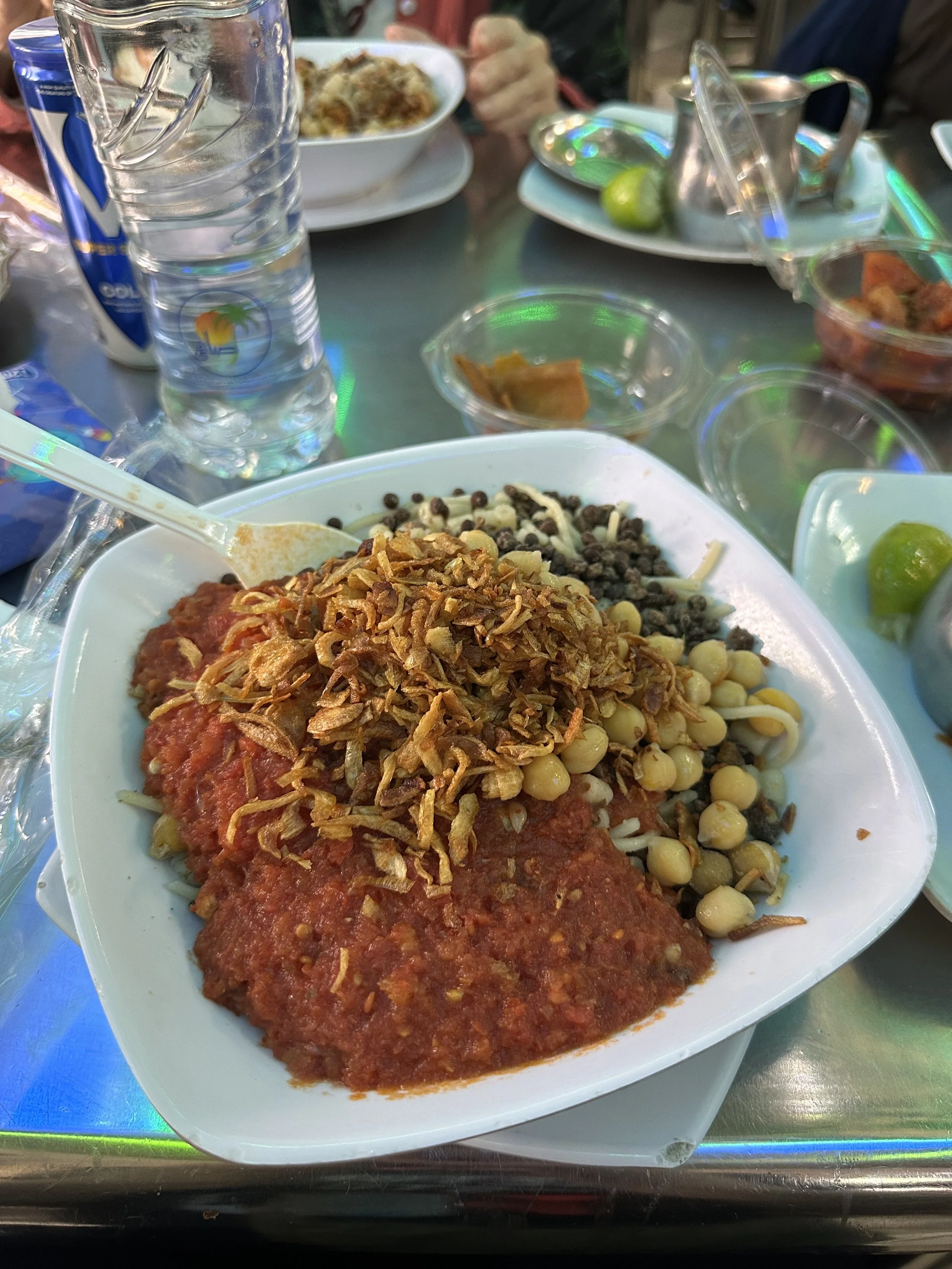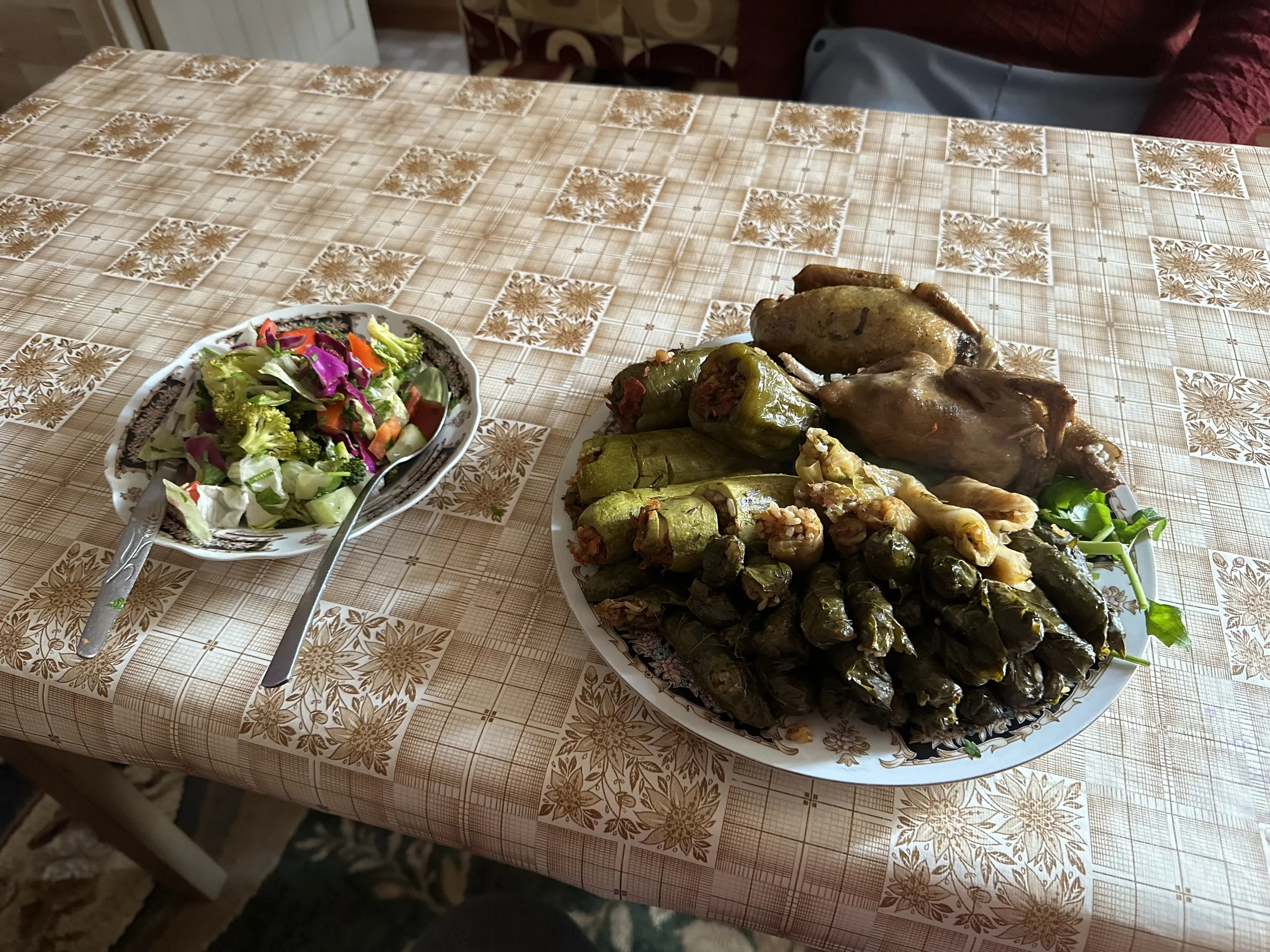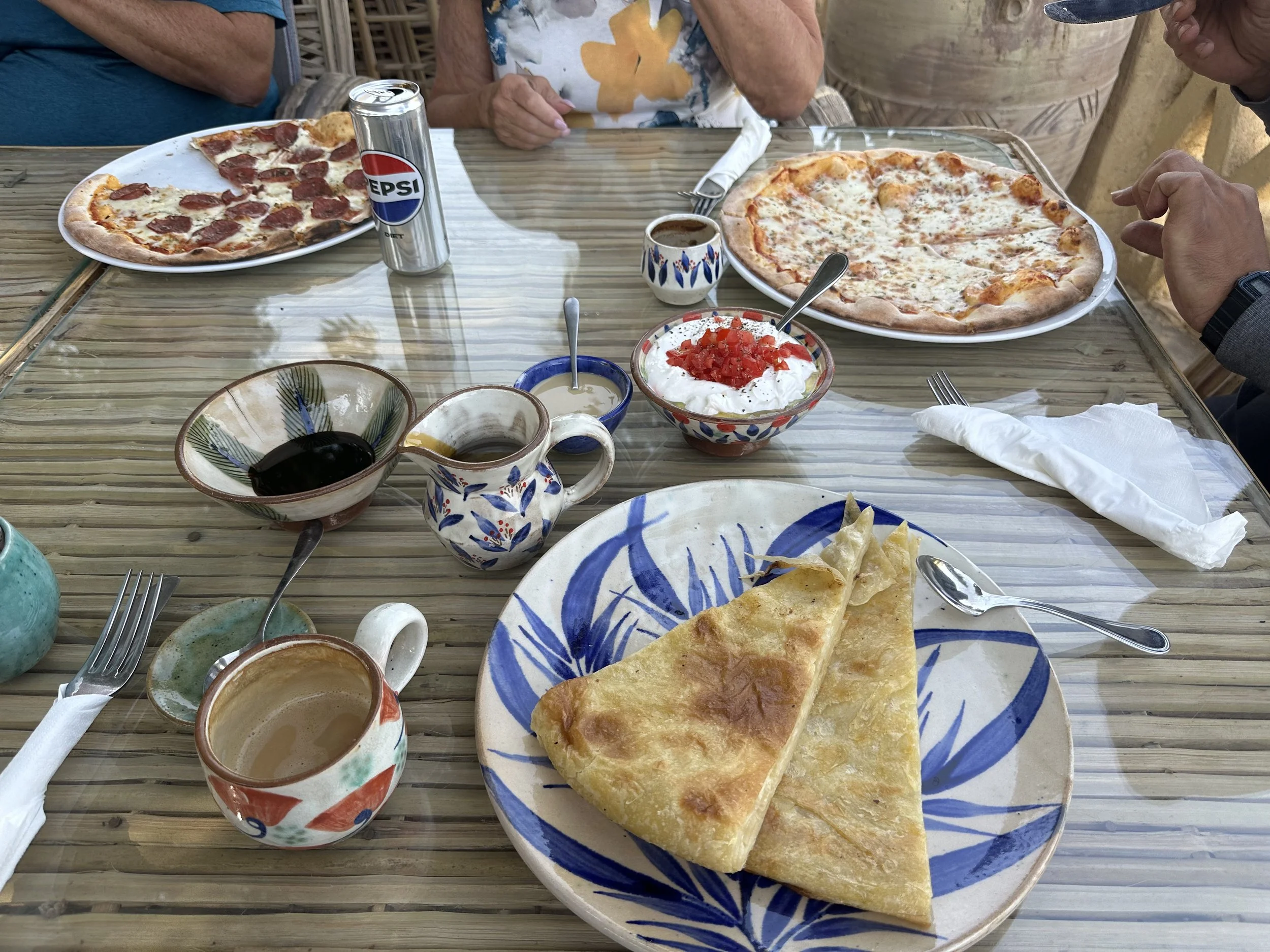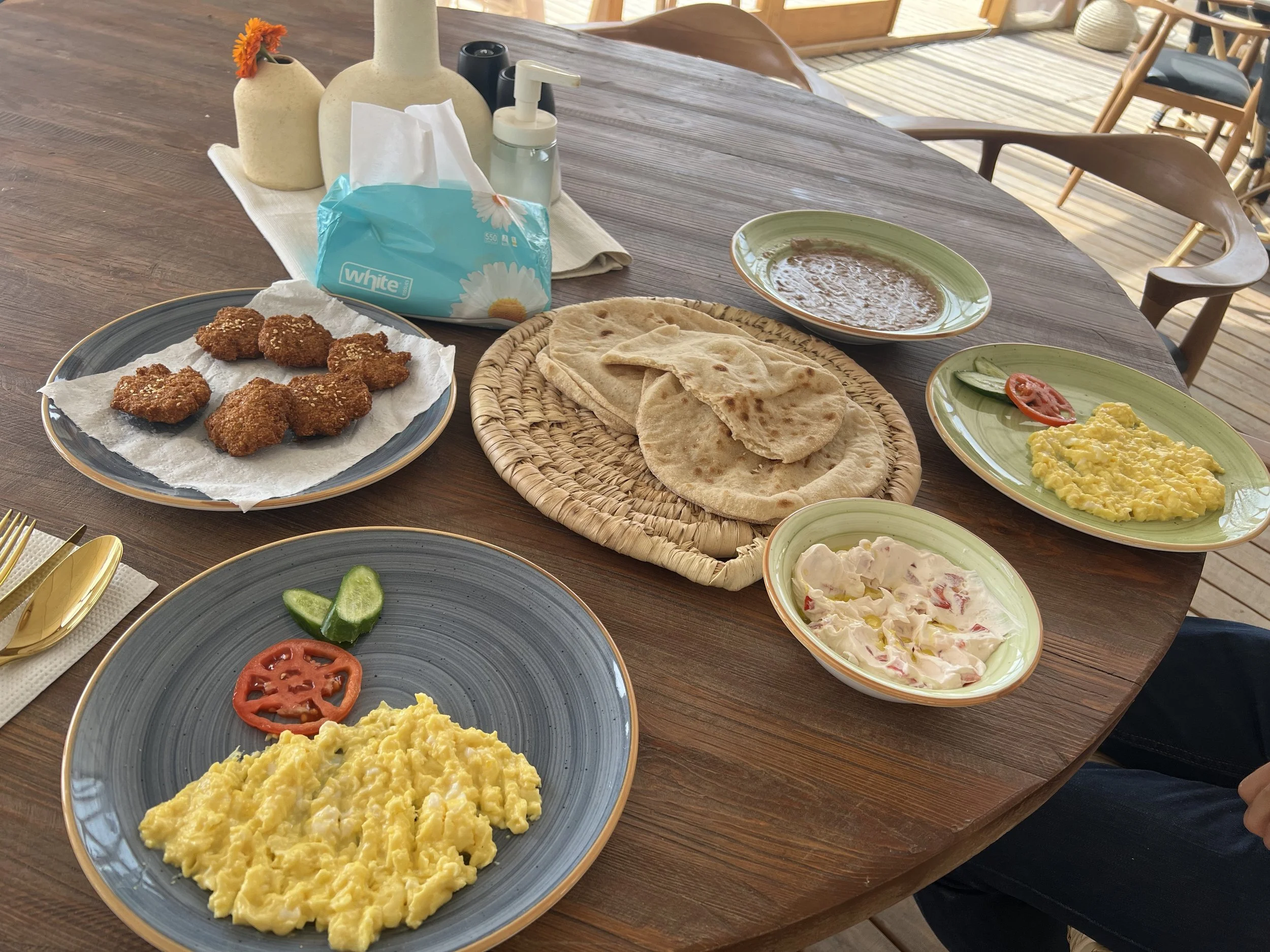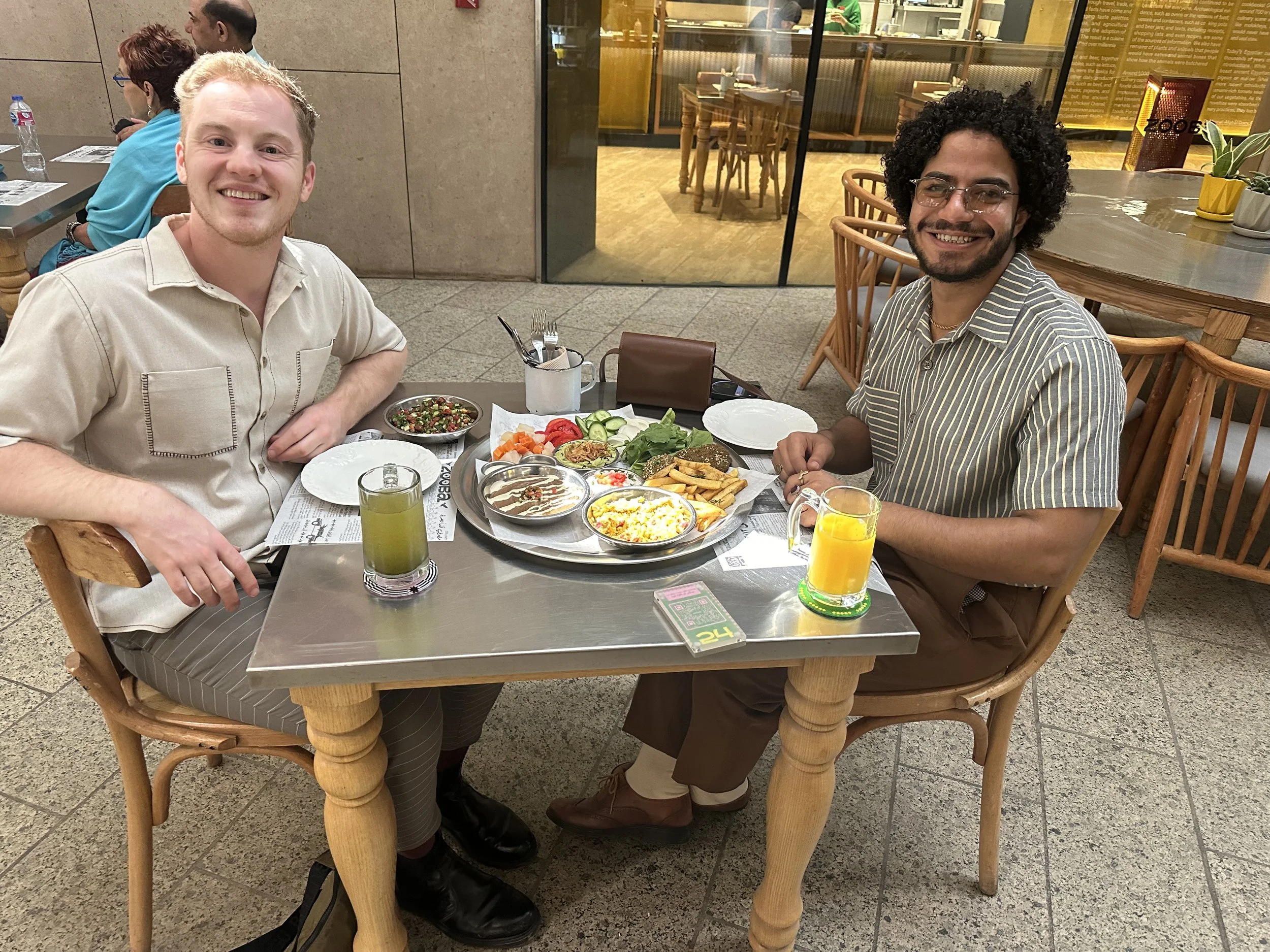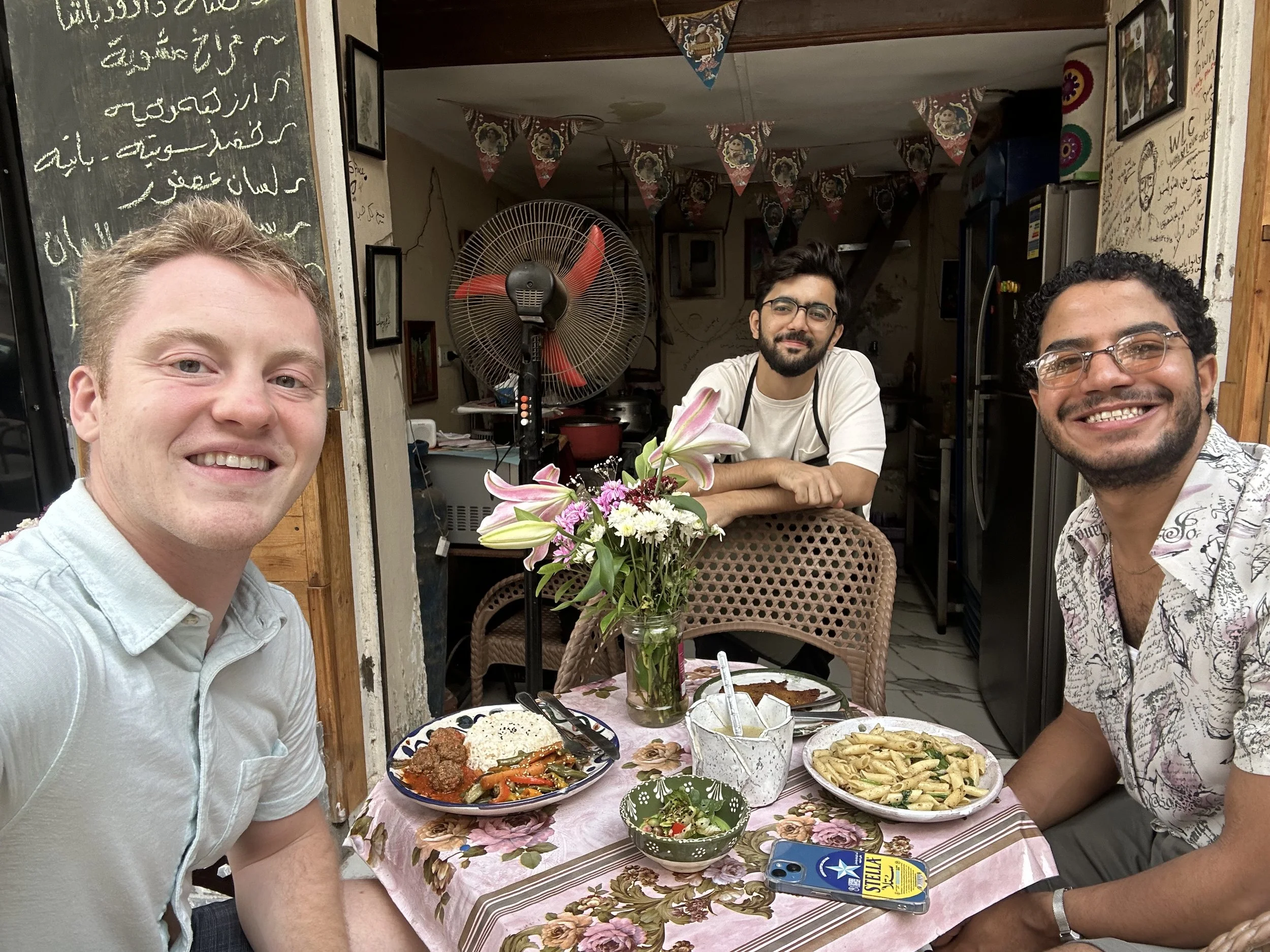Egypt Vegetarian Food: What and Where to Eat!
I’m about to devour a falafel sandwich with a side of arugula and pickles, all vegetarian!
Vegetarian food in Egypt is plentiful and easy to find, because tons of the dishes that Egyptian people eat every single day are naturally vegetarian! In this post, I will share all the best options for Egypt vegetarian food, good restaurants to find vegetarian food, and how to say that you are vegetarian. Luckily, most restaurants in Egypt will have several vegetarian food options, so it’s not too hard to recommend places! You can use this post as a guide when eating out almost anywhere in Egypt, as there should be at least one or two of these food items on any restaurant’s menu.
If you don’t know me already, my name is Gus, and I love Egypt! I have been living in Egypt off and on for over 12 years, I speak fluent Egyptian Arabic, and I have traveled to almost every destination in the country. I now inform travelers about everything Egypt, arrange trips for hundreds of travelers each year, and also personally lead group tours throughout Egypt. If you’d like help with your Egypt trip, fill out an interest form and I’ll get in touch to share how I can make your Egypt adventure come to life, or come on one of my small-group tours of Egypt and Jordan.
Egypt Vegetarian Food: Small Plates, Appetizers, and Sandwiches
Egyptians eat a lot of salads and dips. All the small plates in the middle of the table are vegetarian!
There are tons of vegetarian dishes that Egyptians serve as small plates or appetizers, and in fact, a lot of Egyptians dine in a tapas style, serving meals as tons of small dishes placed in the center of a large round table, and everyone gathers around to enjoy a small amount of each dish. Here are some great vegetarian options that you might see as part of this small-plate ensemble:
Tahini Salad
Eaten with pita bread (salatit tahina bil ayeesh balady in Arabic)
Tahini salad, similar to hummus (without the chickpeas), is a common dip that is served with almost every Egyptian meal. Tahini is made from ground sesame seeds, and then these are mixed with lemon juice, oil, and spices. The result is a creamy dip that is great to eat by itself with some pita bread (ayeesh balady in Arabic), or as a dip for grilled or roasted veggies, or as an additional sauce on a ta’ameya (falafel) sandwich. This dish is also naturally vegan!
Baba Gannoush Salad
Eaten with pita bread (salatit baba ghanoog in Arabic)
Just like tahini salad, baba ganooush is a very common dip that is served alongside many meals. An eggplant is smoked to oblivion, then mashed with a mixture of garlic, tahini, lemon juice, and olive oil. The result is a deliciously creamy and rich dip with a smoky aroma and flavor. Egyptians eat this with pita bread, so grab a piece and get ready to scoop up some Egyptian deliciousness if you order a plate of baba gannoush! This dish is also naturally vegan!
Bessara Salad
Eaten with pita bread (biss-ar-uh in Arabic)
Another salad, bessara’s main ingredient is fava beans, combined with cilantro, chopped parsley, dill, cumin, salt and pepper, and a little bit of mint, blended with some water to create a creamy dip that is enjoyed with pita bread, and topped with some fried onions for extra flavor and some crunch! Don’t let it’s weird green hue take you away from the amazing taste of this dip. This dish is also naturally vegan!
Falafel, or Ta’ameya
Falafel sandwiches are great for any meal of the day!
(fuh-laa-full or TAA-may-yuh in Arabic)
Egyptians refer to falafel as either falafel or Ta’ameya (varies depending on which region you are in, or to whom you’re speaking), but both words are universally understood and used. The main difference between Egyptian falafel and falafel in other places is that fava beans are the main base, instead of chickpeas, making falafel in Egypt more green on the inside, and in my opinion, more delicious! Ta’ameya is made by combining cooked fava beans with several other ingredients, like chopped parsley, salt and pepper, garlic and onion, cilantro, dill, coriander, cumin, and sometimes sesame seeds (added on top). The mixture is combined in a food processor until it forms a pasty dough, which is formed into small balls and deep fried in vegetable oil. Falafel might be served on its own (often eaten with pieces of pita bread), or it is commonly thrown into an open pita pocket, in addition to some cucumbers, tomatoes, lettuce, tahini sauce, and potentially other ingredients like fuul (fava beans), fried eggplant, or french fries. It’s most commonly eaten for breakfast, but usually can be found at any time of day, even late at night, depending on the place.
Foul, or stewed fava beans
Foul (or Ful or Fuul) is a classic Egyptian breakfast food
(fool in Arabic)
Foul, also commonly written as fuul or ful, is made by taking fava beans and simmering them in several cups water until they’re nice and soft, and then mashing them up with other ingredients like salt, cumin, garlic, lemon juice, extra virgin olive oil, and chopped parsley, and stewing the entire mixture for hours, sometimes overnight, in a giant metal urn. Fuul is most commonly served as a breakfast food, and is great in a pita bread sandwich, or if served in a side dish, scooped up with chunks of bread. My favorite place to eat foul is at a 5-star hotel breakfast buffet, because the fuul there is always top notch, and they have what I call a “Foul Bar”, where they have heated foul ready to be scooped into a bowl, and then tons of little accoutrements to pop in, like lemon slices to squeeze, spices like salt, pepper, red pepper, cumin, and coriander, freshly chopped parsley and cilantro, and olive oil and tahini for drizzling over the top. In Alexandria, they have a special version of fuul called “fuul iskandarani”, meaning Alexandria Foul, where the fava bean mixture is cooked with chopped bell peppers, onion, and tomato, adding extra veggies and flavor to the dish. Foul is naturally vegan as well!
Fried potatoes
Egyptians love fried potatoes just as much as we do in the USA!
(buh-tah-tiss in Arabic)
Egyptians love their potatoes, like most other folks around the world, and the most common way to eat potatoes in Egypt is to slice them into french-fry-sized pieces, and then fry them in vegetable oil. Unlike in the USA, potatoes are not commonly eaten with ketchup (Egyptians usually leave the ketchup for pizza, which I’ve never been able to get into!), but are usually dipped in tahini salad, which after trying many many times in Egypt, I can now say I like much better than ketchup for my french fries! In addition to eating them as a side dish, fried potatoes can become the main event in a potato sandwich, which is a piece of pita bread, opened up, stuffed full of french fries, and then drizzled with tahini sauce, for an amazing breakfast option for vegetarians and vegans alike. Fried potatoes in Egypt are also naturally a vegan dish!
Fried eggplant
(bit-en-gan maa-lee in Arabic)
Bitengan is the Arabic word for eggplant, and most of the time when folks in Egypt say “bitengan”, they’re referring to eggplant that has been thinly sliced and fried in oil until it’s so soft it just melts in your mouth. Fried eggplant pieces are commonly served as a side dish to be scooped up with generous pieces of pita bread, or they are added into a pita bread sandwich, sometimes combined with french fries, fuul (stewed fava beans), or falafel, to make a deliciously hearty handheld meal.
Egyptian “Balady” Salad
(salata balady in Arabic)
In Egypt, the word “balady” refers to something local, so balady bread (local bread), and balady salad mean a quintessential Egyptian type of food, and balady salad is Egypt’s most common vegetable salad served at meals. Every Egyptian has their own spin on this dish, but the most common way to prepare balady salad is to finely chop cucumbers, tomatoes, onion, and add parsley, cilantro, and some dill, then squeeze some lemon juice and throw some salt over the entire mix and stir everything together. Balady salad is also a naturally vegan dish
Rice with vermicelli noodles
(rohz bil sh AHr ee-yuh in Arabic)
I never was a fan of rice until I went to Egypt, and tried Egyptian rice the most common way it’s cooked and served: small pieces of vermicelli are cooked in oil (or ghee) until they’re brown and taste oily-delicious, combined with equally delicious (because they are cooked in oil and water), small grain pieces of rice. This dish is sometimes vegan, and sometimes not - it all depends on if the chef has used ghee or butter in the recipe, or just oil, but vegetarians can always count on this dish to hit the spot and to not include any meat!
Lentil Soup
(shor-bit AAHDS in Arabic)
Shorbet Adas, or Egyptian lentil soup, is made with lentils as its main ingredient, making this a great dish for vegetarians wanting some protein in their meal. Lentils are combined with onion, celery, carrots, garlic, cumin, coriander, tomatoes, salt and pepper, and either oil, ghee, or butter for the fat, and after the soup is cooked for a long time under a medium heat, it’s often pureed into a creamy consistency and served with crispy pieces of pita bread. Sorbet Adas is naturally vegan if it’s made with oil, but if it’s prepared with butter or ghee, vegans will want to stick to another option.
Moussaka
(muss-eh-AAH in Arabic): Egyptian Moussaka, unlike it’s more well-known Greek counterpart, usually is a naturally vegan dish, not commonly including any kind of meat or dairy products. To make moussaka, Egyptians combine eggplant and tomato, cooking the mixture to smithereens alongside garlic, onions, and a combination of spices like cumin, coriander, and paprika
Vegetarian Egyptian Food: Entrees and Main Dishes
Even though most Egyptian meals are eaten family style, with tons of the small plates that I mentioned above served in tandem and eaten together, sometimes Egyptians will eat a smaller meal, ordering and eating one main dish. Here are some examples of Egypt vegetarian dishes that can be eaten as the main event.
Vegetable Tagen
(tah-gen khoodar in Arabic)
Egyptian tagins, like the Moroccan tajine, are combinations of meat, vegetables, and sauces, slowly baked in a pot and served hot! In Egypt, the tagin is usually a clay bowl, sometimes covered or uncovered, and a common vegetarian main is a tagin of vegetables. Usually made of green beans, peas, carrots, and potatoes, baked in a delicious tomato sauce, this dish is served alongside rice and pita bread, and makes for a good vegetarian meal. A vegetable tagin is also a naturally vegan dish.
You have to try koshary when you’re in Egypt, and since it’s naturally vegan, it’s great for everybody!
Koshary
(koshary in Arabic)
Koshary is one of Egypt’s national dishes, and it is a bowl of carbohydrate heaven! Koshary is made by combining cooked macaroni noodles, spaghetti noodles, chickpeas, lentils, rice, and topped with fried onions. A hearty smattering of tomato sauce, garlic-vinegar sauce, and hot sauce give the mixture tons of flavor and punch, and one bowl is enough to fill anyone up for an entire meal. The best part is that koshary is naturally vegan as well!
Mahshi
This plate has two stuffed pigeons on it, but the rest of the stuffed vegetables are vegetarian.
(mah-shee in Arabic)
The Arabic word “mahshi” refers to something that is stuffed, and when used by itself, usually means stuffed vegetables. Egyptians will hollow out zucchini and eggplants, or take grape leaves, cabbage leaves, or green bell peppers and stuff them full of spiced rice and then boil them until the veggies melt in your mouth and the delicious rice mixture fills your tummy with Egyptian deliciousness! Mahshi is one of my absolute favorite Egyptian dishes of all time, and I have been known to polish off an entire plate on my own.
Fiteer
Fiteer is heaven in your mouth - I prefer it with cheese, tahini, and molasses
(fuh-teer in Arabic)
Fiteer is often referred to as an Egyptian pancake, but I prefer to call it an Egyptian croissant-crepe, since the flaky layers of the fiteer remind me much more of a round, flattened croissant than they remind me of a pancake. Fiteer can be eaten at any time of the day, and can be served savory or sweet. For breakfast, I love eating fiteer by ripping off huge chunks of the flaky bread, grabbing a chunk of soft white cheese, scraping up some tahini and then dunking the whole mixture in molasses. Savory fiteer is eaten like a pizza, and has topping like veggies, olives, and cheese.
Shakshuka
(shock-SHOO-kuh in Arabic)
Shakshuka is not as common in Egypt as it is in other parts of the Middle East, but you still might find it on some breakfast menus. A skillet is filled with onions, garlic, bell peppers, and tomatoes which are fried with oil and herbs and spices, and then eggs are cracked into the mixture and the whole thing is simmered until the eggs are cooked to your liking. It’s commonly served with Egyptian pita bread and makes a great start to any day!
How to say you are vegetarian in Egyptian Arabic
Vegetarianism in Egypt is not a widely recognized or understood concept; many Egyptians have never heard of someone being vegetarian, and some restaurant staff will scratch their heads if you tell them you are vegetarian, unless you are at a restaurant that sees lots of tourists or is in a hotel.
There is no way to literally say, “I am vegetarian” in Arabic, that most Egyptians will understand. There is a way to easily say you are vegan, though! Veganism is also not understood in Egypt at all (except in very touristy areas), but many Egyptian Christians eat a vegan diet dozens of days each year as part of religious fasting, so if you say in Arabic that you are fasting, any Egyptian will understand that you are only eating vegan food, and will serve you accordingly.
The way to say that you are fasting is to say:
“Ana seyami” (sounds like: eh-nuh see-yaw-mee).
أنا سيامي
If you say these magic words, dishes like foul, koshary, mahshi, a vegetable tagin, vegan rice, and more will magically make their way to you! Many restaurants have an unpublished “fasting menu” even, where they are used to serving Christians who are eating a vegan diet due to religious fasting, so even if you do not see many vegan options on the menu, they may be available if you simply say you are fasting.
Breakfast in Egypt is naturally vegetarian, so you won’t need to order anything special!
So, that’s how you can easily get vegan food, but for vegetarian food (food that could include animal by-products like cheese, eggs, or milk, but does not include any meat or fish), there isn’t an easy phrase to say to communicate these dietary needs.
If you want to try to explain being vegetarian in Arabic, it is best to be extremely specific in your language, and to say that you do not eat chicken, beef, or fish. Egyptians usually think of the word “meat” as meaning only beef, so clarifying that you do not eat any types of meat will help them understand.
In Egyptian Arabic, you can say:
“Ana mabakeltsh ay lahma, asmak, ow frekh, ow ay hewanat”
(sounds like Eh-nuh muh-buh-kelt-sh aye lah-muh, ess-mack, OW fuh-rekh, OW aye hi-yuh-wan-at).
Written in Egyptian Colloquial Arabic, this is:
.انا ماباكلتش اي لحمة اسماك او فراخ او اي حياوانات
This literally translates to: “I do not eat any beef, fish, or chicken, or any animals.”
It should get the message across, but again, since being vegetarian isn’t really understood in Egypt, I think it’s easiest to just stick with the dishes mentioned above that you know are 100% vegetarian, so you don’t get into a confusing conversation! Or, if you are on a group tour of Egypt with me, I will take care of all the Arabic for you, and will help you order all the delicious vegetarian food you want to try during your tour!
Restaurants Serving Egyptian Vegetarian Food
Like I mentioned, almost all restaurants serve vegetarian dishes in Egypt, or they have a special “fasting menu” for Egyptian Christians who are eating a vegan diet due to religious fasting, so you don’t need to seek out any specific restaurants in order to find vegetarian food. In fact, the concept of “vegetarian restaurants” doesn't exist in Egypt, since Egyptians don’t really have any vegetarians, culturally, although certain places, like koshary restaurants or foul/falafel joints naturally serve only vegan or vegetarian food.
Zooba is a great vegetarian chain, and even has a location inside the Grand Egyptian Museum!
Zooba
Zooba has several branches throughout Cairo and also inside the Grand Egyptian Museum, and since they serve a variety of Egyptian food, naturally, many of their dishes are vegetarian! Zooba is a great place to try falafel, foul, dips, and salads, and they also have lots of great sandwich options.
Koshary Abou Tarek
Visiting Koshary Abou Tarek is the best place to try Egypt’s national dish
Koshary is the number one most filling vegan food in Egypt, and Koshary Abou Tarek is the number one spot to try it! They only have one location, in downtown Cairo, and visiting this bustling koshary restaurant is a sightseeing activity in and of itself! If you don’t have the time to go to Koshary Abou Tarek, finding a branch of Sayed Hanafy Koshary or a branch of Koshary El Tahrir are also good options to try Egypt’s national dish. Note: most koshary restaurants are closed for the entire month of Ramadan and also for the Eid Holidays happening after Ramadan, just a heads up!
Bellies en Route Street Food Tours
Ok, so not a restaurant, per se, but Bellies en Route have been offering great street food tours, market tours, and cooking classes for years, and they cater specifically to vegetarian travelers! They stop at several great local places throughout an afternoon or evening tour of downtown Cairo, and this walking foodie dream places an emphasis on vegetarian food, as most of their options are veg-friendly!
Tabkhaa Space
Tabkhaa Space is a small kitchen run by my friend Hakeem, and he always has vegetarian and vegan options on his ever-changing daily menu!
A tiny sidewalk kitchen run by a very friendly Egyptian guy, Hakeem, who makes homemade Egyptian dishes every day (except Fridays and major holidays). Hakeem speaks English very well and he caters specifically to vegan and vegetarian diners, by always offering a few options every day for folks with those dietary needs, and also clearly explaining what he has on hand that day that is vegetarian or vegan. Check out this video in order to learn more about Hakeem’s restaurant and how to find out the menu of the day!
Foul or Falafel Joints (all over the place)
There are tons of spots, large and small, in Egypt that serve mostly foul and falafel, vegetarian and vegan staples! There’s Mohamed Ahmed in Alexandria, or in Cairo, El Sharouq or Bashandy are great options. If you ask anyone where to find foul or falafel, chances are there will be a place close by!
Fiteer Sultan
Sultan is the place to get fiteer in Cairo, and you can go sweet (nutella with bananas is my favorite here) or savory (cheese, veggies, olives, and whatever else you’d like!) – either way you’ll get a great vegetarian-Egyptian “pizza” to enjoy!
With all the Egypt vegetarian food that’s out there, now that you know how to order vegetarian food at Egyptian restaurants, and armed with some recommendations for good places to sample Egyptian food, what questions do you have? What vegetarian food did I miss? Have you tried any of these foods or restaurants, and what did you think? I love reading and replying to all of my readers’ comments! Until next time, happy eating!

